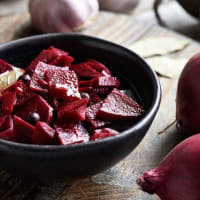Me Ahem! You know what? Contrary to what Japanese people normally think, I know that the word “fry” means itameru, while “deep-fry” is ageru. But the other day, you uttered the expressions “fried chicken” and “fried shrimp” to describe tori-no-kara-age and ebi-furai. I think your English is wrong!
私 エッヘン! あのね、日本人が普通思ってるのとは逆に、英語のfryは「炒める」、deep-fryは「揚げる」という意味のこと僕は知ってるよ。でも、こないだダリちゃんは、「鶏のから揚げ」や「エビフライ」のことをfried chickenやfried shrimpって言ってたよね。僕はあなたの英語、間違いだと思うんだ。

Dali What do you know? I’m a native English speaker! OK, I’ll tell you. Actually, the word “fry” has two meanings. It is used to refer to two different ways of cooking. One, for example, is the way we cook fried chicken or fried shrimp, in which chicken and shrimp are cooked in deep oil.
ダリちゃん 何言ってるの? わしは英語ネイティブだよ! まあまあ、教えてやろう。実際fryという単語には二つの意味があるんだ。二つの異なる料理法を表現するのに使われる。一つはたとえばfried chickenやfried shrimpを調理する方法で、鶏やエビをたっぷりの油の中で調理するんだ。
Me Humm… What’s the other?
私 ふ~ん……もう一つは?
Dali The other meaning of “fry” is that of teppanyaki, which is the most common meaning of "fry.“ As you know, in teppanyaki, you use a small amount of oil on a flat frypan or on a griddle.
ダリちゃん fryの他の意味は「鉄板焼き」、これがfryの最も普通の意味。あのね、「鉄板焼き」では平らなフライパンや鉄板の上で少量の油を使うでしょう?

Me So, “fry” means itameru, right?
私 じゃあfryの意味は「炒める」でしょう?
Dali Umm…itameru is a kind of fry…But when you are doing itameru, you always move the chukanabe―moving and stir, moving and stir, sha, sha, sha. We call this “stir-fry.”
ダリちゃん う~ん……「炒める」はfryの一種だけど……でも、「炒める」とき中華鍋を普通、振るでしょう? 動かしてかき混ぜて、動かしてかき混ぜて、シャシャシャ。わしらはこれをstir-fryというんだ。

Me Stir-fry?
私 stir-fryだって?
Dali Yes. Stir-fry means to cook on a frypan or on a griddle while constantly stirring.
ダリちゃん そう。stir-fryはフライパンや鉄板の上で常にかき混ぜながら調理するという意味。
Me Ho, ho!
私 ホ、ホー!
Dali On the other hand, when doing “regular fry,” as in the case of teppanyaki, unlike with itameru, food is not stirred.
ダリちゃん 一方、「鉄板焼き」のケースのように、普通にfryするときには、「炒める」のとは違い食材はかき混ぜない。
Me I’m so confused!
私 むっちゃ分からなくなった!
Dali Americans usually say “fry,” for deep-fried food, like “fried shrimp” or “fried chicken.” But if we want to avoid confusion with the teppanyaki meaning of “fry,” we use the expression “deep-fry,” just for clarification.
ダリちゃん アメリカ人は普通、fried shrimpやfried chickenのようにたっぷりの油で揚げた食べ物を指すのにfryを使う。でも、「鉄板焼き」の意味でのfryとの混乱を避けたいときは、明確にする意味でdeep-fryを使う。
Me Oh, I had no idea!
私 ワー、初めて知った!
Dali I think when Japanese use the word furai, it always means “deep-fry.”
ダリちゃん 日本人が「フライ」という単語を使う場合、常にdeep-fryを意味すると思うよ。
Me Hmm…
私 ふ~ん……

Dali For okonomiyaki, we just say fry. You know, in many Japanese izakayas, there are two kinds of gyoza. These are fried gyoza and deep-fried gyoza. Fried gyoza is yaki-gyoza and deep-fried gyoza is age-gyoza. Do you get it?
ダリちゃん 「お好み焼き」ではわしらは単にfryを使う。日本の居酒屋ではよく二種類の餃子があるでしょう? fried gyozaとdeep-fried gyozaだ。fried gyozaは「焼き餃子」でdeep-fried gyozaは「揚げ餃子」だ。わかった?

Key words(キーワード)
fry: (を油で)炒める(揚げる)(日本の「フライ」のように小麦粉やパン粉をつけて油に浸して「揚げる」の意のときにはdeep-fryというのが正確
deep-fry: 油をたっぷり使って(食品を)揚げる
ahem: えへん、うふん
you know what?: あのさ、あのね、ちょっと聞いてよ
contrary to: とは逆に、裏腹に
utter: (声・言葉などを)口から発する、(考え・気持などを)述べる
describe: (を)言葉で述べる、説明する
what do you know?: あなたが何を知っているのか、何も知らないくせに
refer to: (を)参照する、(に)言及する
griddle: (菓子などを焼く)鉄板、フライパン
stir: 混ぜる、攪拌する、かき混ぜる
stir-fry: (かき混ぜながら)強火ですばやく炒める
confuse: (を)混乱させる、わかりにくくする
avoid: 避ける、よける、回避する
confusion: 混乱、乱雑、困惑、混同
expression: 表現、言い回し、語法
clarification: 明確化、説明、釈明
Comments(コメント)
After our conversation, I kind of got the difference between “fry” and “deep-fry.”
会話後、僕はfryとdeep-fryの違いが少しわかったような気がした。




















